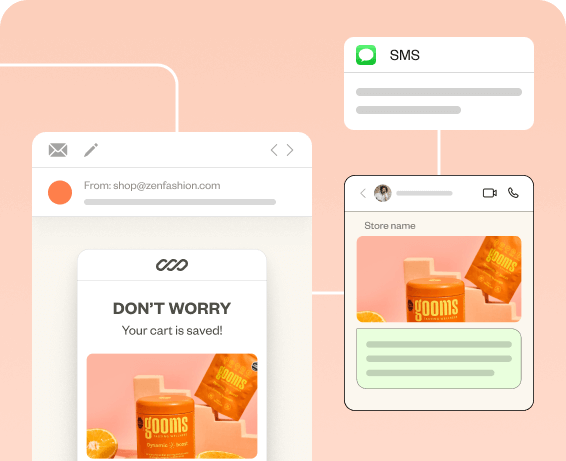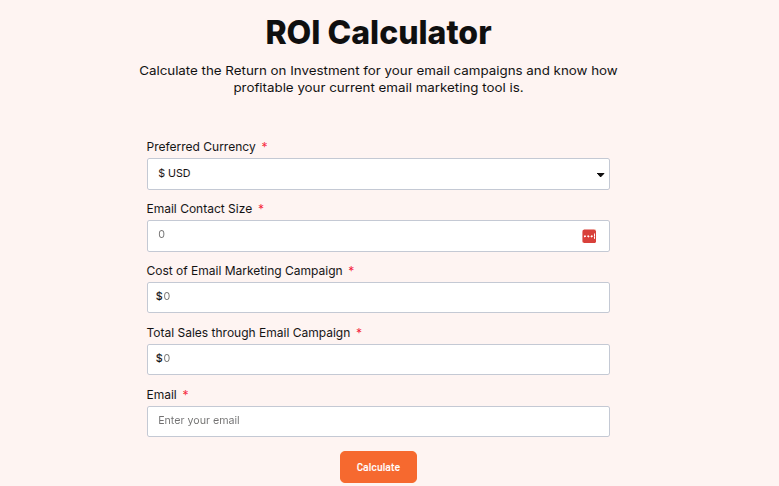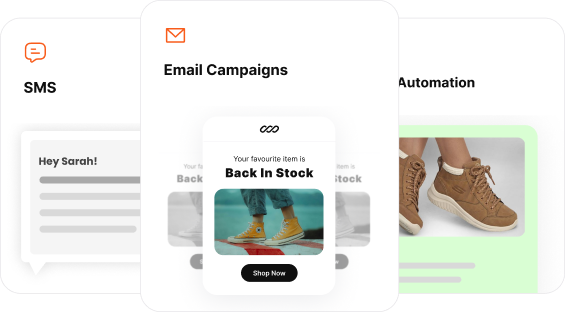Tracking your email marketing ROI is essential in understanding the effectiveness of your marketing campaigns. Since emails have the highest ROI of any digital marketing channel, they present an excellent platform for driving conversions and retention.
Whether you are selling a product or service, be it B2B or B2C, if the customer finds it valuable, they will open the email. Therefore, measuring your email marketing ROI becomes essential as it directly links your marketing efforts to real business outcomes.
In this article, you’ll learn what email marketing ROI is and how to calculate your return on investment in the simplest way possible. Additionally, we’ll share proven strategies that can effectively improve your email marketing return on investment (ROI).
Increase your email marketing ROI by sending personalized emails to your target audience that drive more conversions using Retainful.
What is ROI in Email Marketing?
ROI in email marketing is a measure of how much earnings you’ve made through email campaigns compared to what you’ve spent on them. This metric tells you the amount you’ve made for every dollar you spent sending emails to your subscribers.
For example, you ran an abandoned cart email campaign that cost you $25. And, within a few days, 10 customers returned to complete their purchases, generating $300. It means that for every $1 you spend on email marketing, you earn $12.
Sometimes, you also experience a negative email marketing ROI. Thus, it acts as an indicator to identify which campaigns are performing well and which require optimization to improve results.
Email Marketing Metrics You Must Track
The first step in calculating your ROI is to understand the email marketing metrics associated with it. This would help adjust your email marketing strategies and reallocate resources smartly. Here are some key email metrics.
- Open Rate: As the name suggests, open rate is the percentage of recipients who open your emails. It is calculated by dividing the number of emails opened by the number of emails delivered.
- Click-Through Rate: Every email you send holds at least one or two links. The percentage of recipients who clicked on these links in your email constitutes the click-through rate (CTR). A higher CTR indicates that your email is aligning with your audience and you are going in the right direction.
- Conversion Rate: For eCommerce businesses, conversion rate means making a purchase, signing up for a service, or filling out a form. Conversion rate is the ultimate measure of the success of your email marketing campaign.
- Bounce Rate: This value is something that should not be higher. The higher your bounce rate, the higher the number of emails that are not delivered to your recipients. Make sure your email bounce rate doesn’t affect your conversion rates.
- Revenue Per Email: RPE or Revenue per Email helps measure the revenue generated per email sent to your recipients. This metric is important for tracking your sales directly from email marketing and promotions.
Although numerous metrics exist in email marketing, sticking to the essential ones listed above helps you track marketing returns effectively.
Above all, ask yourself, “What is your Email Marketing goal?” Whether it’s building brand awareness, generating leads, or boosting sales, email marketing can help you achieve a variety of objectives.
Learn More: 14 Inspiring Lead Nurturing Examples to Re-engage Your Audience.
How to Calculate Your Email Marketing ROI
Here’s the simplest formula to calculate your email marketing ROI.
ROI = (Revenue – Cost) ÷ Cost
- Revenue: Revenue is the money that you’ve earned through email marketing. It can include sales, generating leads, abandoned cart recovery, cross-promotion, upselling, and more.
- Cost: This refers to the amount of money spent on sending emails. Key areas include email list building, email design and content, email marketing tools, etc.
Learn More: 11 Best Email List Building Tools to Increase Conversions.
Your return on Investment (ROI) value differs based on the above variables. Here’s how you interpret these values based on different scenarios.
a) Positive ROI (Successful Campaign)
Revenue: $1500
Cost: $500
ROI = (1500-500) ÷ 500 × 100 = 200%
Here, your ROI value is 200%, meaning your is a successful email marketing campaign and is driving profitable results.
b) Negative ROI (Unsuccessful Campaign)
A negative email marketing ROI means your campaign resulted in a loss. This happens when the revenue is less than the cost of running the campaign.
Revenue: $300
Cost: $500
ROI = (300 – 500) ÷ 500 × 100 = -40%
Here, your ROI is -40%, meaning you lost 40% of the money you spent on your marketing campaign. You may need to re-evaluate your strategy for a better email marketing ROI.
c) Break-even ROI (Neutral Campaign)
In this scenario, your revenue is equal to the cost of your marketing campaign, meaning you neither lose nor gain money.
Revenue: $500
Cost: $500
ROI = (500-500) ÷ 500 × 100 = 0%
A 0% email marketing ROI means your campaign broke even. You neither made profits nor did you lose money. This ain’t ideal, but could be a starting point to analyze other factors like customer quality, email list segmentation, etc.
These scenarios help you assess your email marketing strategies and optimize future performance.
Curious about your specific ROI? Get your estimate using our email marketing ROI calculator.
7 Proven Email Marketing Strategies to Increase Your ROI
If you are getting low returns from your email marketing efforts, it’s high time you need to apply new email marketing strategies or optimized your existing ones.
While the success of email marketing largely depends on the creativity and preferences of the marketer, it is important not to overlook some time-tested marketing strategies. Below is a quick overview of all the best email marketing strategies to increase your email marketing ROI.
1. Building an Email List
Building a strong email list is the most crucial step that ensures you reach out to people who are interested in your product or service. This ultimately leads to better engagement and conversions.
Some of the email acquisition strategies include,
- Showing website Pop Up and Sign-ups.
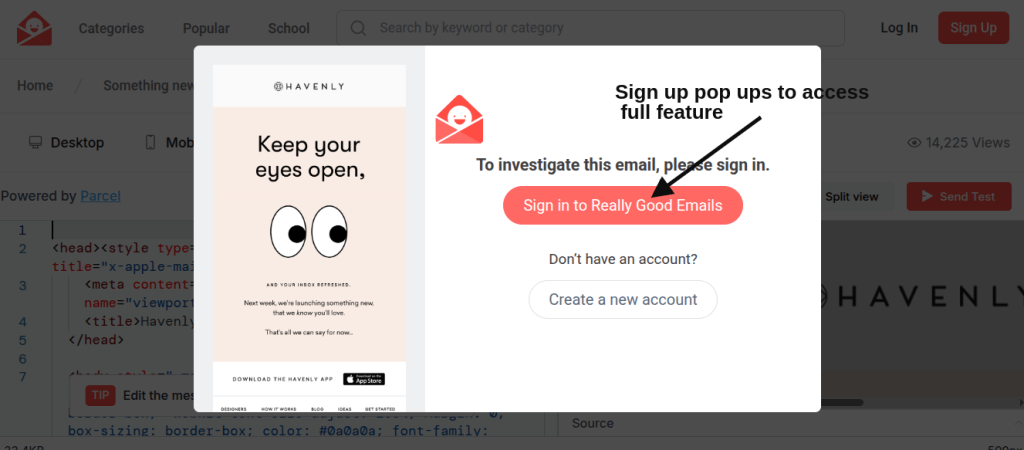
- Social Media Promotions
- Creating lead magnets that attract new customers
- Referral Programs
Create targeted email lists for your marketing campaign and get a higher return on investment (ROI) and increased engagement rates using Retainful.
2. Create Effective & Engaging Email Content
According to Zipia’s study on email open rates, 47% of email recipients open emails only when their subject lines are engaging. Therefore, having an effective email subject line along with content is essential to engage your audience. Here are the key sections to take care of.
- Email Subject Line: Email subject lines must grab attention immediately. Try experimenting with different subject lines with urgency, personalization, etc.
- Email Content: No one wants to read a lengthy email. So, keep your email content crisp, short, and most importantly, “valuable.” You can also incorporate catchy visuals or customer testimonials.
- Call To Action: Make sure your CTA is clear and compelling. Use actionable language such as “Shop Now” or “Claim Your Discount”.
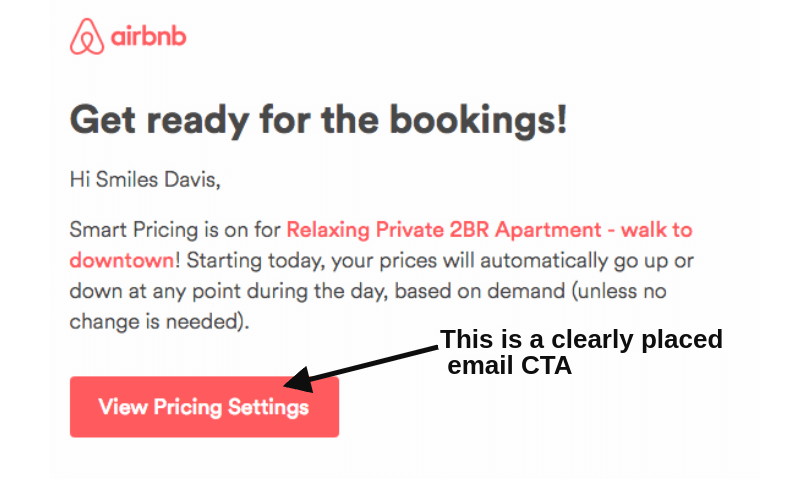
Many email marketing tools, such as Retainful, come with an AI assistant that generates email subject lines, hence making your job much easier.
3. Personalized Emails
Email personalization is not about first/last names. It’s about relevant content and making your target audience feel like VIPs. Since customers are overloaded with countless emails, personalizing your emails gives you leverage over other brands. All you need to do is,
- Segment your email list based on user behavior, such as previous purchases, browsing history, location, etc.
Learn More: What’s the difference between email segmentation and personalization.
- Use dynamic content that sends personalized emails based on customer actions such as previous purchases, browsing activity, etc. In this way, you can increase your customer lifetime value (CLV).
4. Cleaning Your Email List
Clearing inactive subscribers from your email list time and again is crucial to improving engagement rates and reducing unnecessary marketing expenditures. Some quick tips to clear your inactive recipients are given below.
- Remove email subscribers who haven’t engaged with your emails for a while. Segment your email list based on engagement factors such as open rates, clicks, and conversions.
- Use tools such as Retainful to create an email suppression list that prevents sending emails to audiences who have unsubscribed, repeatedly bounced, or have your emails in their spam folder.
As a result, you improve your email deliverability, save on sending costs, and enhance your campaign performance.
5. Analytics to Measure Performance
Analytics helps you understand what’s working and what’s not. Tracking campaign metrics like open rates, click-through rates, and conversion rates will allow you to optimize it continuously and get a better email marketing ROI.
Every business has a different time frame to seriously look at the analytics of a campaign. Some take 24 hours, while some take 10 days or even a month, based on your niche.
The larger your audience or subscriber base, the more essential it is to have email marketing tools at your disposal. For example, “Retainful,” an email marketing platform, provides all the essential metrics on its dashboard, including email opens, clicks, unsubscribes, skips, and even the revenue generated through these emails.
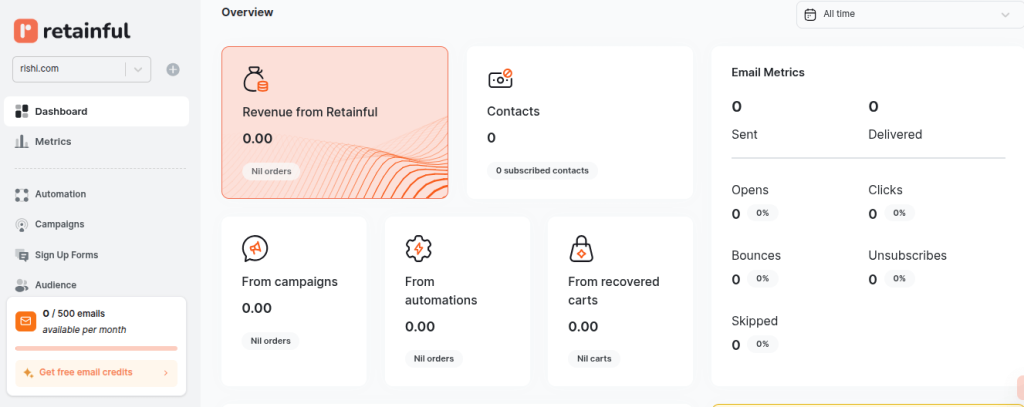
6. Email List Segmentation
Sending the right email to the right audience and at the right time is the sole purpose of segmenting your email list. This allows you to send more targeted emails to specific groups of people, which, therefore, increases engagement and ultimately, conversions.
There are innumerable ways to segment your email list. Some example email segmentation strategies include,
- Segmenting your list by demographics (age, gender), purchase history (past purchases, browsing history), or engagement levels (active, inactive subscribers).
- Creating tailored email campaigns for each segment, such as sending a welcome email to new subscribers or offering special discounts to frequent buyers.
7. Email Automation
In simple terms, email automation involves using software tools and platforms to automatically send emails to your subscribers based on pre-defined triggers. This entirely removes the need to manually send emails to your audience.
- You can create automated email workflows for common customer interactions, such as welcome emails, abandoned cart emails, and post-purchase follow-ups. Or, simply use email marketing tools like “Retainful” which has every workflow pre-built.
Learn More: 10 Marketing Automation Workflow Examples + Flow Charts.
- Create trigger-based emails based on specific actions of customers, like a subscriber joining your list or making a purchase.
Email automation has an indirect but significant impact on your email marketing ROI. It can improve various aspects of your marketing, such as efficiency, email personalization, targeting, lead nurturing, etc, all of which ultimately increase your revenue and cut down customer acquisition cost (CAC).
Email Marketing Delivers the Best Returns: Key Statistics
Marketing trends worldwide indicate email marketing consistently delivers the best ROI compared to other marketing channels.
The often quoted email marketing ROI statistic of generating $36 for every $1 spent isn’t fully accurate, as it overlooks other significant factors like subscription acquisition costs, platform fees, and tool investments.
When factoring in these additional costs, the average roi for email marketing gives $4 for every $1 spent, which remains higher than the ROI of other marketing channels. Below is an infographic comparing email marketing ROI with other channels.
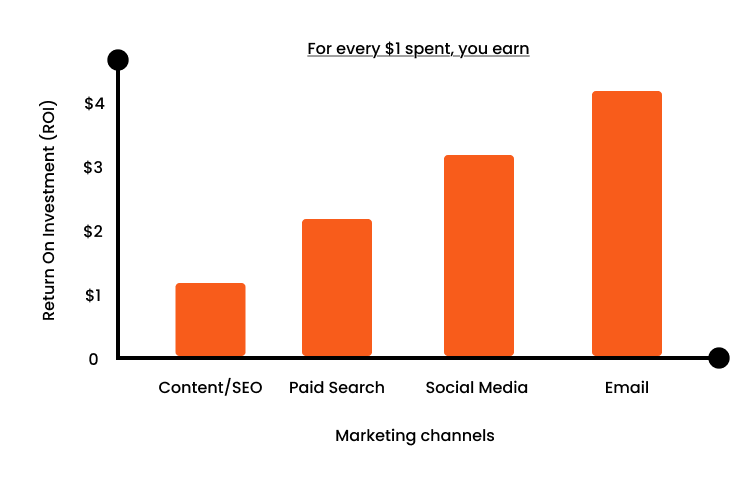
According to Oberlo, the number of email users is projected to reach approximately 4.42 billion by 2025, with this number expected to continue growing.
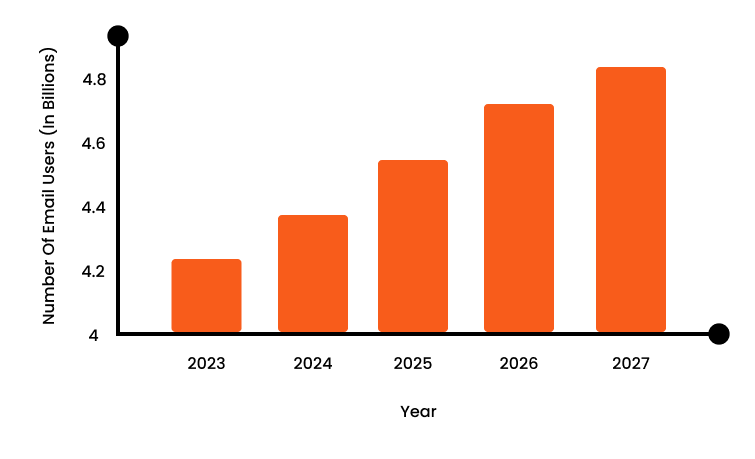
The ROI through email marketing has been on an upward trend since 2020. In 2024, revenue generated through email marketing reached approximately $12.33 billion worldwide (Source: HubSpot). Here’s a projection of email marketing ROI for 2025 and beyond.
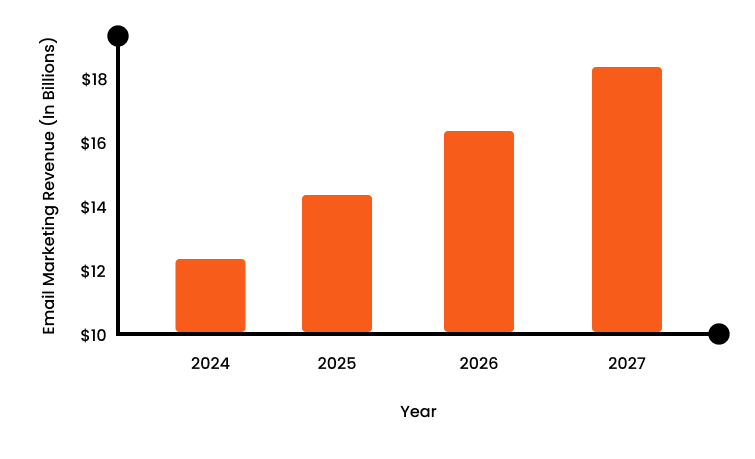
Above all, your email marketing ROI depends on your niche. For instance, the revenue potential of eCommerce/Retail industries stands high, while financial services often see lower potential returns.
Email marketing ROI differs from one industry to another. Every industry you take has several variable factors such as customer engagement, type of products/service, sales cycle, email frequency, email list size, and many more.
So overall, emails are still very much a powerhouse with the highest ROI for most industries. Doesn’t matter if it is a B2B, B2C, or small business; you just need to send emails that are valuable to them.
Automate your email marketing campaign using Retainful and send emails at the right time that increase your return on investment (ROI).
The Big Picture
Email marketing doesn’t end with just measuring your ROI, it’s a continuous process of refining your strategies, optimizing your email content, and understanding your audience to get better results.
It’s also about experimenting with different email versions and adjusting to what delivers the highest return on investment. A simple catchphrase to remember is: “Always focus on what’s in it for your customers”.
If you are not seeing the results you hoped for, stay locked in, analyze, and start off again with new insights. Based on your audience size, don’t hesitate to use email marketing tools too.
Remember, the long game always pays off in the end. So, while it’s important to track email marketing ROI, don’t forget to consider brand awareness too, as it plays a pivotal role in long-term success.
Related Read:
Frequently Asked Questions
Tools like Retainful help track and analyze email marketing performance, offering data like open rates, clicks, conversions, and overall ROI. With Retainful, you can automate email sequences and measure their effectiveness, optimizing campaigns for better results.
Email marketing generally delivers higher ROI compared to social media. Social media can drive engagement and brand awareness, but email marketing often results in more direct conversions and customer retention.
Factors that affect email marketing ROI include email list quality, engagement levels, email content, design, personalization, and timing. Regularly cleaning your list and using targeted, relevant content will maximize your return.
A/B testing in email marketing involves sending two versions of an email to different segments of your audience to see which one performs better. Email testing allows you to experiment with subject lines, CTAs, and content to optimize future campaigns for higher returns.
A good email marketing ROI varies depending on industry and campaign goals. The average return on email marketing is around $42 for every $1 spent. Achieving a high ROI email marketing requires optimizing strategies such as segmentation, personalization, and timing. For businesses aiming for optimal performance, understanding B2B email marketing ROI is crucial.

